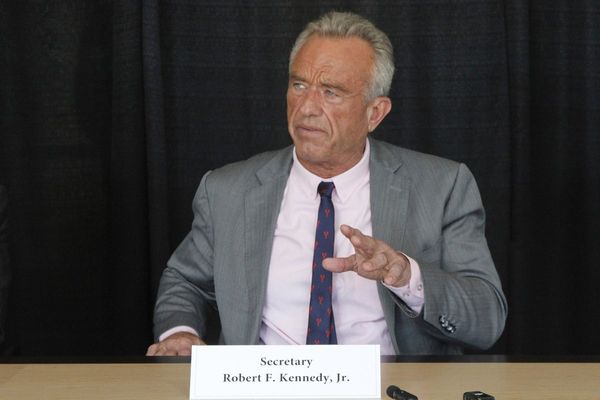
From towering granite monoliths to textured tree trunks, Ansel Adams’s renowned black and white photographs have offered generations the chance to see the beauty and importance of nature through his eyes.
Now a new exhibit at San Francisco’s de Young fine arts museum gives viewers a new way to connect to the artist himself. Ansel Adams in Our Time, on display from 8 April through 23 July, brings together more than a 100 of Adams’s works alongside 23 contemporary photographers who reflect and build on it. The exhibition also returns Adams to the city where he launched his career and continues the conversations he began about conservation and national parks in his first exhibition at San Francisco’s de Young museum nearly a century ago.

The exhibition will include some of Adams’s most famous works, including a photograph of Half Dome under the moon and a beloved self-portrait featuring the artist’s shadow – complete with his arm extended to the sky, light meter in hand – against a rock face in Monument Valley.
Alongside, the gallery walls will also portray perspectives from new artists whose photos build on Adams’s work while seeking broader reflections on the natural world and the way people engage and impact it.
These include collages created by Mark Klett and Byron Wolfe, who layer photographs from Adams and others over more modern captures, leaving viewers with panoramic views of Yosemite through time. Catherine Opie’s photographs sharply contrasts Adams by casting similar subjects in a colored blur while CJ Heyliger, the exhibit’s youngest artist, showcased beauty in the mundane by focusing on details in landscapes less sought after, like glass scattered across the desert.
“It is great to see contemporary photographers taking up his legacy and looking at it, criticizing it, and finding new ways to approach these problems that Adams was addressing in his photographs years ago,” said Sarah Mackay, an assistant curator for the show.

‘Ahead of his time’
A master technician, Adams stewarded his images through an arduous photographic process, starting with lugging large cameras up steep terrain, enduring long waits for good light, and finally the metered dance – set to the beat of the metronome he once relied on as a musician – of darkroom development that granted him ultimate control over the final outcome. But in his writings and recordings, Adams credits his impact not to his technique, but to his eye.
“The whole world is, to me, very much ‘alive,’ all the little growing things, even the rocks,” Adams once wrote. “I can’t look at a swell bit of grass and earth, for instance, without feeling the essential life – the things going on – within them,” he said. “The same goes for a mountain, or a bit of the ocean, or a magnificent piece of old wood.”


His work has taken on renewed urgency as the iconic locations he photographed across the American west – including Death Valley, Grand Teton and Yosemite – grapple with a changing climate.
Positioning Adams’s work alongside that of contemporary environmental artists offers visitors a new framing of the climate crisis and the importance of conservation.
“The thing I find so exciting is realizing how ahead of his time Ansel Adams was in terms of thinking about these issues,” said Karen Haas, lane senior curator of Photographs Museum of Fine Arts, Boston.
Adams is perhaps most associated with Yosemite national park, and his images of its sweeping views and soaring granite slabs through the seasons helped shape the park’s identity while it in turn shaped him as a photographer.
Armed with what he called the “spiritual-emotional” connection to the park and other wild landscapes, Adams’s portrayal helped ensure the national parks would remain protected places. In 1975 he took his message to the White House, gifting President Gerald Ford with a print of Yosemite. “Now, Mr President, every time you look at this picture,” he urged, “I want you to remember your obligation to the national parks.”
National parks in peril
Today those parks remain cherished but also in peril, caught between the pressures of extreme weather and surging tourism. Photography that spurred appreciation for the wilderness has also helped flood these areas with footsteps. Growing crowds and tourist-catering amenities are increasingly at odds with conservation efforts as parks push past their capacity.
Adams saw the problems unfolding even in his time and often resisted what he called “resortism” in the parks and their development for public use. In his images he typically erases signs of people to offer a more pristine view of the landscapes.

“We see Ansel Adams photographs and we don’t see them peopled,” Mackay said. “He is in some instances removing them from his photographs.”
Yosemite – one of the most visited parks in the nation – is a quintessential example of the difficult balancing act between enabling access and ensuring the lands are preserved for generations to come.
The past year has put the extreme seasonal swings that Yosemite faces on full display. In summer the park was shrouded in smoke from nearby wildfires, followed by a winter of snowstorms that closed down the park for weeks and damaged the winding mountain roads leading into the valley.
The curators feel strongly that Adams would have had a perspective to share about how these issues have unfolded. That’s why, they said, including new artistic voices has elevated the potential for impact.

“It’s bleak realizing how little has changed and how much work we still have to do,” said Haas reflecting on the enormous scale of problems posed by a warming world. But, she added, the exhibit has brought her hope, with its potential to both inspire awe and action. It’s a feeling she hopes viewers share.
“With this exhibition we can finally put this great master in conversation,” she said, “and let these contemporary figures show us the concerns that continue today.”







